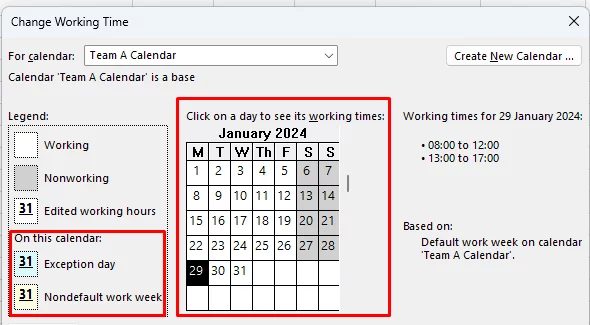
[Quick Guide] Creating A Calendar In Microsoft Project
Contents
When it comes to project management:
Planning and effective organisation are the cornerstones of success.
Having a clear calendar for you and your team is a great way to handle both!
Let’s dig in to how you can make a calendar and how it can help you.
Calendars – Step-By-Step Guide
- Open Microsoft Project and open your project file or create a new one.
- Navigate to the ‘Project’ tab on the top menu and click on ‘Change Working Time’.

- You’ll see a list of default calendars in the ‘Change Working Time’ dialogue box. Choose the one that closely matches your desired calendar, like the ‘Standard’ calendar.
- To customise the calendar, click on the ‘Create New Calendar’ button. Give it a descriptive name, like ‘Team A Calendar’.
- Now, you can specify working hours, non-working days and exceptions. To set working hours, double-click on a workday and set the ‘From’ and ‘To’ timings. Select the day(s) for non-working days and mark them as non-working.
- For exceptions, like public holidays or annual leave, click on the ‘Exceptions’ tab and add them accordingly.
- Once you’ve tailored the calendar to your requirements, click ‘OK’ to save the changes.
- Now you can assign this custom calendar to individual tasks or resources by selecting them, navigating to the ‘Task Information’ or ‘Resource Information’ dialogue box, and choosing the appropriate calendar from the dropdown list.
By creating and assigning custom calendars, you can ensure that tasks and resources are scheduled accurately, taking into account their specific working hours and availability.
This allows for efficient resource allocation and precise project planning, ensuring that your project stays on track and delivers successful outcomes.
How Are They Useful For The User?
Microsoft Project Calendars offer a multitude of benefits to the user.
1 – They enable precise planning by accounting for public holidays, annual leave, and other non-working periods, resulting in more accurate project schedules and timelines.
2 – Users can better allocate resources by knowing their availability, preventing overloading and optimising their productivity.
3 – These calendars facilitate effective collaboration by aligning the working hours of various teams and stakeholders, streamlining communication and coordination.
Lastly, they empower project managers to proactively identify potential scheduling conflicts and adjust plans accordingly, mitigating risks and ensuring smooth project execution.
By harnessing the power of Microsoft Project Calendars, users can create a well-structured planner that maximises efficiency and leads to successful project outcomes.
Calendars – Resource Allocation
In the process of creating a planner in Microsoft Project, calendars play a crucial role in effectively allocating resources to the individuals working on the project.
By defining specific working hours and non-working periods for both tasks and resources, project managers can ensure that resources are only assigned to activities during their available working hours.
This eliminates the risk of overloading team members and helps distribute the workload evenly, preventing burnout and enhancing productivity.
Additionally, calendars allow project managers to set resource-specific exceptions, such as annual leave or non-working days, ensuring that assignments are adjusted automatically to accommodate these absences.
How Does This Save Time?
The integration of calendars in Microsoft Project significantly saves time during a project’s planning and resource allocation phase. With calendars defining the working hours and availability of resources, project managers can swiftly identify periods when team members are free to take on new tasks.
This time-saving aspect not only streamlines the planning process but also allows project managers to focus on other critical aspects of the project, leading to increased efficiency and smoother project execution.
If you’re looking for some time management tips to make sure your project runs on time, then read more on the Eat That Frog technique.
But if you want to dig deeper then check out our Microsoft Project Courses and learn more!
Conclusion
Throughout the journey of creating a planner in Microsoft Project, we have acquired essential skills to master the art of project planning and scheduling.
Understanding the significance of Microsoft Project Calendars has been the cornerstone of effective resource allocation and precise task scheduling.
By customising calendars to match the unique working hours of teams and resources, we have learned to optimise project workflows, ensure even work distribution and prevent the overloading of individuals.
Additionally, we’ve harnessed the power of automated scheduling, saving valuable time by eliminating manual coordination and adjustments.
If you would like to analyse other options before committing to Microsoft Project, check out this article about Microsoft Project’s pros and cons.




